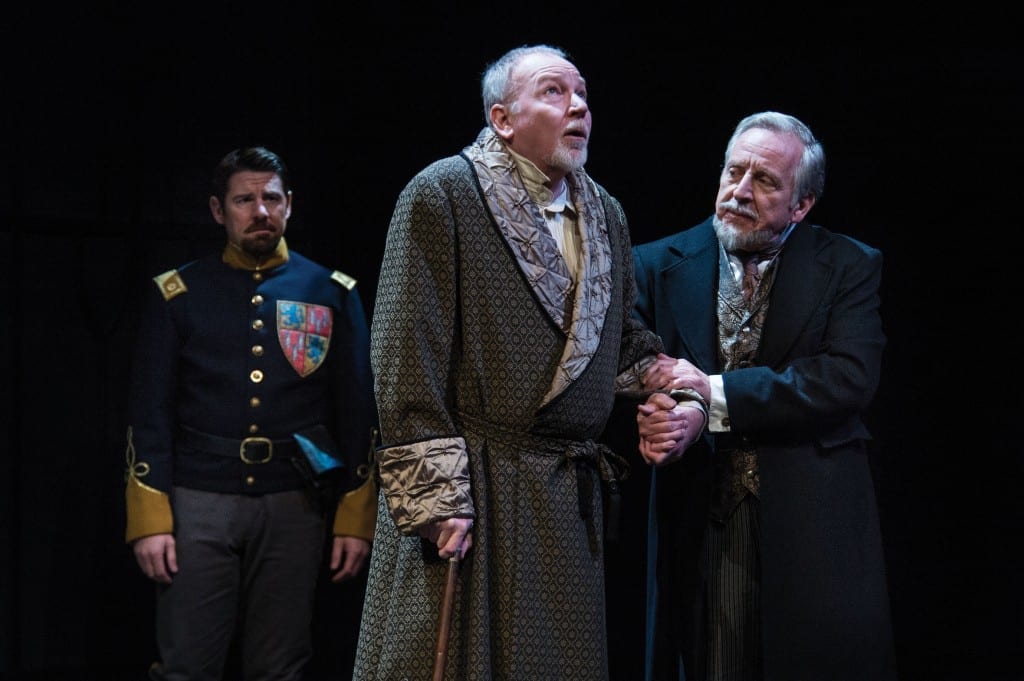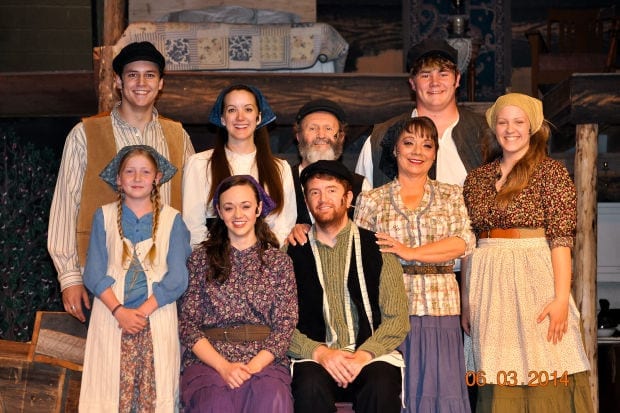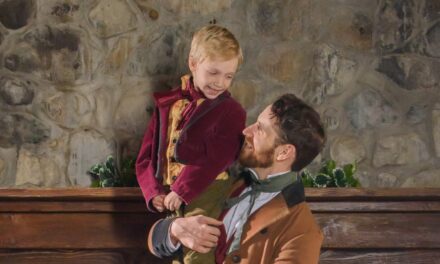CEDAR CITY — One line from the title character encapsulates Richard II at the Utah Shakespeare Festival: “Now mark me how I will undo myself.” As the play unfolds, the audience watches a monarch who is overthrown because of shortsighted decisions and a philosophical inflexibility that prevents him from adapting to the forces of change around him.

Matt Mueller (left) as Bishop of Carlisle David Ivers as Richard II in the Utah Shakespeare Festival’s 2013 production of Richard II. (Photo by Karl Hugh. Copyright Utah Shakespeare Festival 2013.) Show closes October 19, 2013.
David Ivers plays the title role, a monarch who believes that God has put him in power and that no earthly force can dislodge him. As played by Ivers, Richard’s self-confidence knows no bounds, even when the reality of his political situation is staring him in the face, such as in the castle scene in the third act. Every time Richard reasserted his divine appointment to anyone who would listen (a group that dwindles as the play progresses), Ivers displayed fully a hubris that in rarely rivaled in the theatre. What was interesting though, is that each claim of divine authority became increasingly desperate and less assured—a progression in character that was helped me feel pathos for the fallen king, rather than a feeling that he deserved his fate.
Facing off against Richard is his nephew Bullingbrook, played by Larry Bull. In Bull’s portrayal, Bullingbrook was outraged at his personal loss of rights, but also the dangers that Richard posed to England as a whole. It would have been so easy for Bull to show his character as being selfishly motivated to become king, but in his scenes where Bullingbrook plans with his confederates it was always clear that his character also had England’s greater interests at heart.

Brian Vaughn as Earl of Northumberland in the Utah Shakespeare Festival’s 2013 production of Richard II. (Photo by Karl Hugh. Copyright Utah Shakespeare Festival 2013.)
Among the supporting cast my favorite performer was Dan Kremer as John of Gaunt. The firebrand uncle of King Richard was most emotional in his final scene, when John knew he was dying and therefore had nothing to lose, and told Richard what the king needed to hear. Melissa Graves as Richard’s queen was a welcomed contrast to the male-heavy cast, and her distress in the garden scene and her final scene of the play injected tender moments of humanity into the political drama.
Director Henry Woronicz opened the production with the first of many compelling stage pictures. The technique was successful in establishing Richard’s court as a place of ennui and decadent opulence—and not responsible statecraft. Woronicz’s greatest success, though, was in the abdication scene, which was effective in evoking sympathy for Richard (in spite of his foolishness) because it showed that Richard had no choice but to accept his position as a usurped king. Notwithstanding the political nature of the play, Woronicz also found an emotional core for the characters, such as in Richard’s last scene with his queen. Through much of the scene the king and queen held hands, a very natural and human action for any middle-aged married couple that was looking for solace in one another during a crisis.
Woronicz’s directing was generally visually and emotionally compelling, but I also found some minor flaws in it, too. To me the most interesting subplot involves the actions of Richard’s favorites, Bushy (Rhett Guter), Bagot (Matt Zambrano), and Green (Betsy Mugavero). I was disappointed in the disinterested way that the three talked about their plans and also in the anticlimactic nature of the scene where Bullingbrook orders the execution of his prisoners. I also felt the pacing of the play gradually grew slower as it progressed, but this may be because of the weird structure of the play. With the central conflict over at the end of Act Four, Shakespeare spends much of the last act setting up the next play in the series (Henry IV, Part 1), either directly—such as in describing the future Henry V—or indirectly—such as the subplot involving the Duke of Aumerle (Drew Shirley), which shows the precarious nature of the new king’s grasp on power.

David Ivers (left) as Richard II, Larry Bull as Henry Bullingbrook, and Dan Frezza as Edmund of Langley in the Utah Shakespeare Festival’s 2013 production of Richard II. (Photo by Karl Hugh. Copyright Utah Shakespeare Festival 2013.)
Woronicz moved the action of the play to the Edwardian period, with the court dressed in smart turn-of-the-20th-century suits and dresses and with the rebels dressed in World War I-era uniforms (all designed by Bill Black). Jaymi Lee Smith‘s lighting added a cold, detached feeling to the scenes of Richard’s court, which I felt reflected his interest in competent governance. Smith also used lighting to show appropriate changes in the mood of scenes, such as when Richard breaks the mirror. Finally, Barry G. Funderburg‘s music felt like a film score and helped me understand the tone of each scene. My favorite musical moment came in the final act, when Richard was in prison and started to hear music; Funderburg created a slightly haunting melody that matched the action of the scene perfectly.
Thematically, I applaud the Utah Shakespeare Festival for producing Richard II immediately after this year’s King John. In addition to being the two Shakespeare histories that take place the earliest, they also have fascinating opposing themes. I stated in my review of King John this year that John was a realistic politician, willing to be flexible and bend with the times. Richard II is precisely the opposite and his rigid belief that “right makes might” leads to his downfall. Seeing the two shows in the same season was a real treat, and I hope that more theatre companies will see the two pieces as companion works.
On the other hand, Richard II is clearly the superior script. Except for the “guild the lily” speech, King John is almost completely devoid of the poetic language that makes Shakespeare Shakespeare. In Richard II, however, the script is full of poetic imagery about England, the tongue, the nature of power, and more. Plus, the numerous poetic couplets make the language particularly delightful and makes the work feel reminiscent of Shakespeare’s other more poetic plays, such as Romeo and Juliet.
Overall, the superb acting and pleasant designs helped me realize that Richard II is one of the most underrated of Shakespeare’s plays. The Utah Shakespeare Festival has created an excellent installment of their Complete the Canon initiative to produce every Shakespeare play over the course of 12 years.







